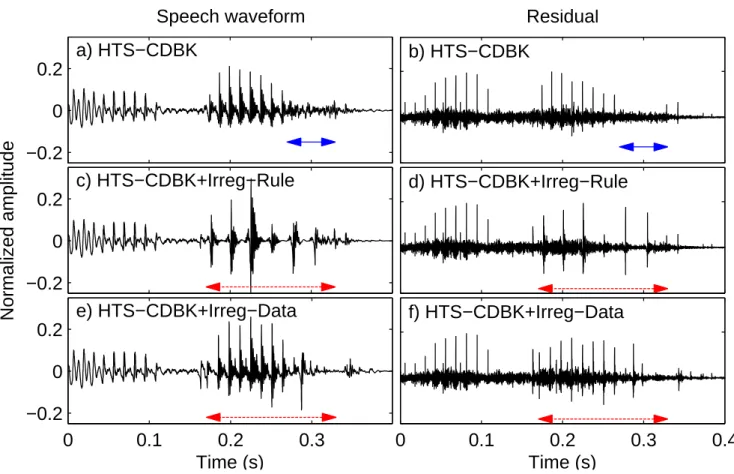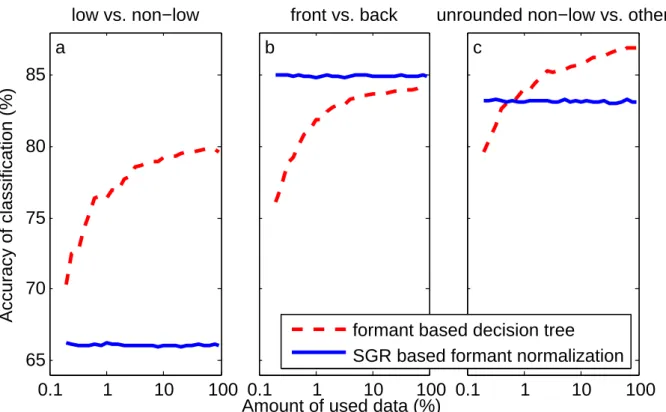Statistical parametric speech synthesis, which is a state-of-the-art technique in the domain, also uses the source-filter model [2]. In the second thesis group, I show the speech synthesis aspects of the excitation model and introduce two new irregular voice models that can be used in statistical parametric speech synthesis. The result of the training is the small HMM database, which can be used in synthesis.
They can be categorized according to the properties of the excitation signal and the type of spectral filtering. Some solutions have proposed the application of the Harmonic Plus Noise (HNM) model within the HTS framework and use the maximum sound frequency [12] or the sound cutoff frequency [13]. In [16], the Deterministic Plus Stochastic Model (DSM) of residual signal is proposed and integrated into HTS.
It arises from abrupt changes in the length and/or amplitude of the pitch periods or both. However, it does not focus on the characteristics of the squeaky excitation of the original speaker. Next, the Speech Event Detection using the Residual Excitation And a Mean-based Signal (SEDREAMS) algorithm is used to find the glottal period boundaries (GCI locations) in the voiced parts of the speech signal.
The input of the synthesis is the parameters obtained during analysis (F0, gain, rt0, HN R and M GC) and the codebook of pitch-synchronous residuals. The results of the irregular-regular transformation method were tested on the speech data of four Hungarian speakers (3 males: FF1, FF3 and FF4 and one female: NO3) from the PPBA database [27]. After that, the parameters were adapted to the training part of the HTS-HUN system [7].
6 shows an example for the results of the HTS-CDBK (a and b) and HTS-CDBK+Irreg-Rule (c and d) systems. Scaling the gain by random factors resulted in strong damping of the amplitude of the fourth cycle. 6 shows an example for the residual waveform and speech of the data-driven irregular voice model (e and f).
Similar to the baseline HTS-CDBK system (a and b), the last vowel of the HTS-CDBK+Irreg-Data residual only contains irregular-like voice (amplitude attenuations) in the last part of the vowel. The measurements were performed on the speech data of the two speakers (10-10 words synthesized by the baseline system, by the rule-based and data-driven models; 10-10 original regular and original irregular recordings). 7: Results of the acoustic analysis on the synthesized samples with the baseline system and irregular voice models.
In the first experiment, we investigated the role of the subglottal system in Hungarian vowels.
![Fig. 1: Pulse-train excitation in the baseline HTS system. Source: [7], with modi- modi-fications.](https://thumb-eu.123doks.com/thumbv2/9dokorg/2498081.294428/4.892.104.792.482.738/fig-pulse-train-excitation-baseline-hts-source-fications.webp)
Applicability of the results
If, according to the results, the ratio between F2 and Sg2 was not in accordance with Theorem III.1 (it was not true for front vowels that F2 > Sg2 and back vowels that F2 < Sg2), then it was more difficult for the listeners to recognize the original vowel. We expect that the wrong F2−Sg2 ratio is unfavorable from perceptual aspects and makes understanding speech difficult. It might be possible to create a method based on the above expectation to remove the unsuitable speech sounds from training databases, thus contributing to making synthesized speech more intelligible.
The classifier presented in Thesis III.2 can be extended to classify longer sound sequences (eg CV or VC transitions) into articulatory groups, which has been previously investigated for American English. If the source filter model used in Markov model-based covert speech synthesis can be extended by modeling subglottal resonances, it can further improve the naturalness of the synthesized speech.
Acknowledgement
Abbreviations
Notations
Alwan, “Automatic detection of second subglottal resonance and its application to speaker normalization,” The Journal of the Acoustical Society of America, vol. Olaszy, “Prec´ızi´os, p´arhuzamos magyar besz´edadatb´azis szész´ese ´es szolg´altat´asai [Development and services of the Hungarian precisely tagged and segmented parallel speech database] (in Hungarian),” Besz´ edkutat´as 2013 [Speech Research 2013], p. G´osy, “Magyar spont´anbesz´ed-adatb´azis - BEA [Hungarian Spontaneous Speech Database] (in Hungarian),” Besz´edkutat´as 2008 [Speech Research 2008], pp.
Klatt, "Analysis, synthesis, and detection of voice quality variation between female and male speakers.", The Journal of the Acoustical Society of America, vol. Goldman, “Comparisons between aerodynamic, electroglottographic, and acoustic spectral measurements of the female voice,” Journal of Speech and Hearing Research, vol. Alwan, “An improved correction formula for harmonic magnitude estimation and its application to open quotient estimation,” in Proc.
Publications
J4] Tam´as G´abor Csap´o, Tekla Etelka Gr´aczi, Zsuzsanna B´ark´anyi, Andr´as Beke, Steven M. Lulich, ,Patterns of Hungarian vowel production and perception with respect to subglottal resonances, ”The Phonetician, No. C1] Tam´as G´abor Csap´o, G´eza N´emeth, ,Transformation of Irregular Voice to Modal Voice by Residual Analysis and Synthesis,” IEEE Signal Processing Letters, in preparation , 2013.
C2] Tam´as G´abor Csap´o, G´eza N´emeth, ,A new irregular voice model for HMM-based speech synthesis,”ISCA 8th Speech Synthesis Workshop (SSW8), (Barcelona, Spain) , p. C3] Tam´as G´abor Csap´o, G´eza N´emeth, ,A new codebook-based excitation model for use in speech synthesis,”IEEE CogInfoCom 2012, (Kosice, Slovakia), pp. C4] Tam´as G´abor Csap´o, Zsuzsanna B´ark´anyi, Tekla Etelka Gr´aczi, Tam´as B˝ohm, Steven M.
C6] Csap´o Tam´as G´abor, B´ark´anyi Zsuzsanna, Gr´aczi Tekla Etelka, Beke Andr´as, B˝ohm Tam´as, ,A mag´anhangz´o-form´ansok ´ es a szubglott´alis rezonanci´ak ¨osszef¨ugg´ese a spont´an besz´edben,”. J5] Tam´as G´abor Csap´o, Csaba Zaink´o, G´eza N´emeth, ,A Study of Prosodic Variability Methods in a Corpus-Based Unit Selection Text-To-Speech System," Infocommunications Journal, Vol.








